roof NISSAN NV200 2016 Owners Manual
[x] Cancel search | Manufacturer: NISSAN, Model Year: 2016, Model line: NV200, Model: NISSAN NV200 2016Pages: 312, PDF Size: 6.65 MB
Page 11 of 312
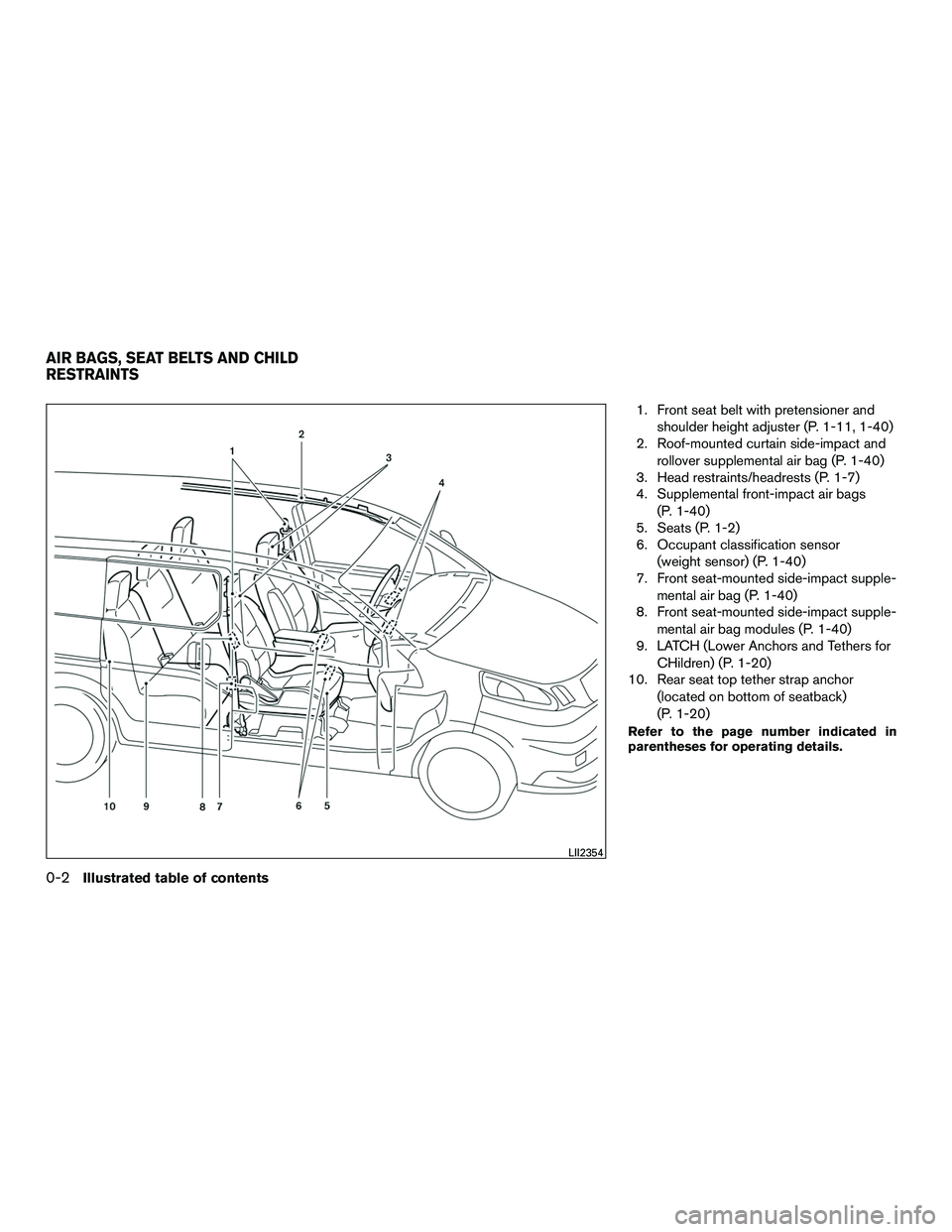
1. Front seat belt with pretensioner andshoulder height adjuster (P. 1-11, 1-40)
2. Roof-mounted curtain side-impact and
rollover supplemental air bag (P. 1-40)
3. Head restraints/headrests (P. 1-7)
4. Supplemental front-impact air bags
(P. 1-40)
5. Seats (P. 1-2)
6. Occupant classification sensor
(weight sensor) (P. 1-40)
7. Front seat-mounted side-impact supple-
mental air bag (P. 1-40)
8. Front seat-mounted side-impact supple-
mental air bag modules (P. 1-40)
9. LATCH (Lower Anchors and Tethers for
CHildren) (P. 1-20)
10. Rear seat top tether strap anchor
(located on bottom of seatback)
(P. 1-20)
Refer to the page number indicated in
parentheses for operating details.
LII2354
AIR BAGS, SEAT BELTS AND CHILD
RESTRAINTS
0-2Illustrated table of contents
Page 12 of 312
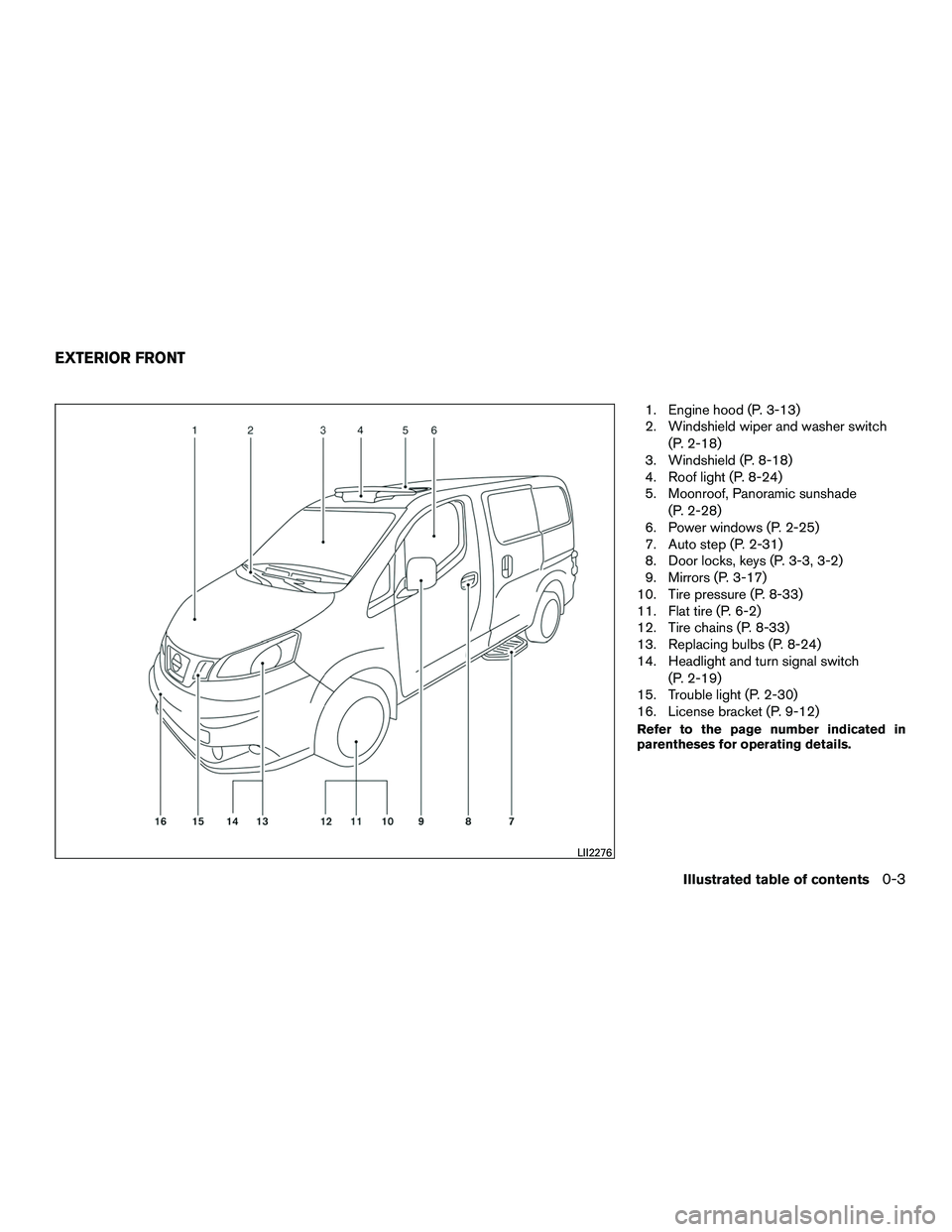
1. Engine hood (P. 3-13)
2. Windshield wiper and washer switch(P. 2-18)
3. Windshield (P. 8-18)
4. Roof light (P. 8-24)
5. Moonroof, Panoramic sunshade
(P. 2-28)
6. Power windows (P. 2-25)
7. Auto step (P. 2-31)
8. Door locks, keys (P. 3-3, 3-2)
9. Mirrors (P. 3-17)
10. Tire pressure (P. 8-33)
11. Flat tire (P. 6-2)
12. Tire chains (P. 8-33)
13. Replacing bulbs (P. 8-24)
14. Headlight and turn signal switch
(P. 2-19)
15. Trouble light (P. 2-30)
16. License bracket (P. 9-12)
Refer to the page number indicated in
parentheses for operating details.
LII2276
EXTERIOR FRONT
Illustrated table of contents0-3
Page 59 of 312
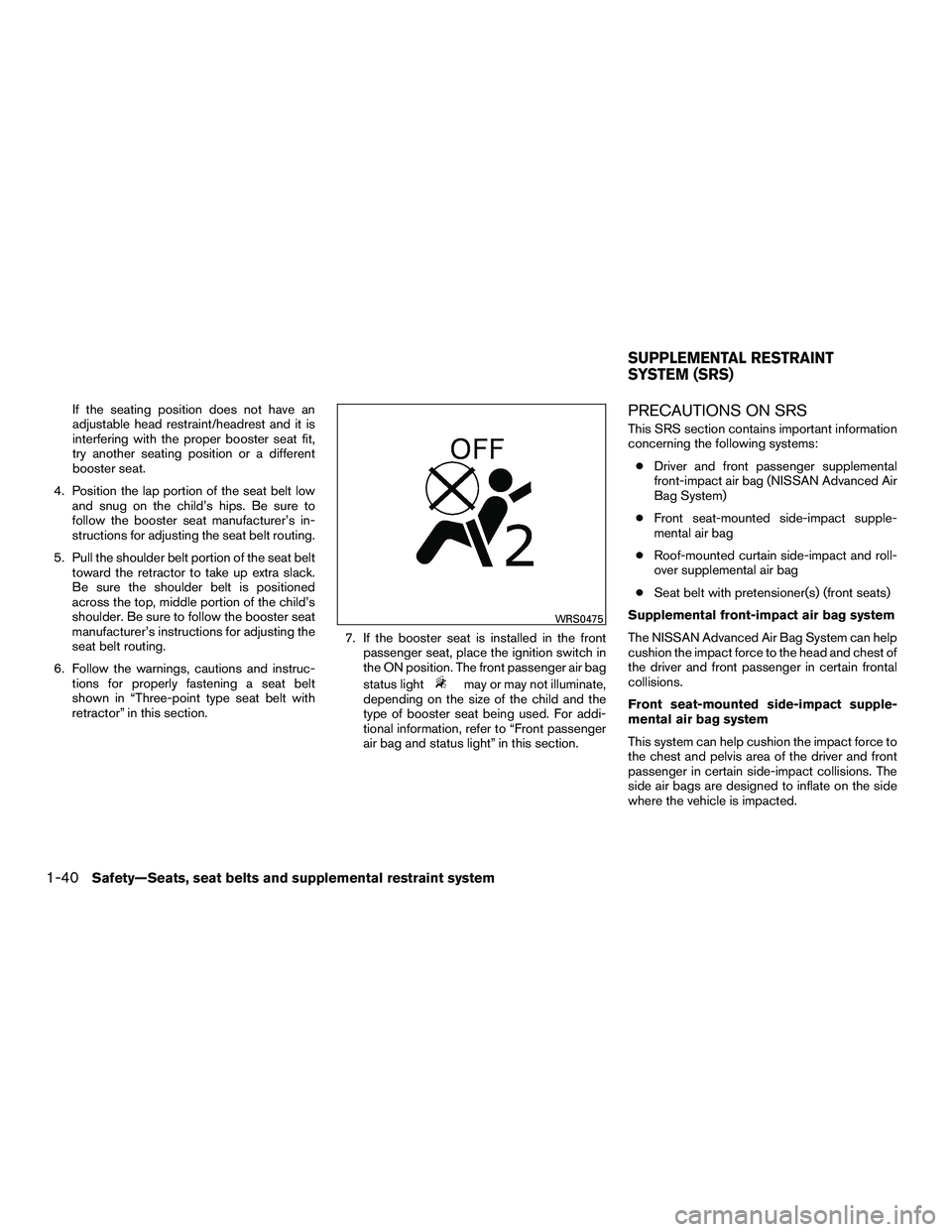
If the seating position does not have an
adjustable head restraint/headrest and it is
interfering with the proper booster seat fit,
try another seating position or a different
booster seat.
4. Position the lap portion of the seat belt low and snug on the child’s hips. Be sure to
follow the booster seat manufacturer’s in-
structions for adjusting the seat belt routing.
5. Pull the shoulder belt portion of the seat belt toward the retractor to take up extra slack.
Be sure the shoulder belt is positioned
across the top, middle portion of the child’s
shoulder. Be sure to follow the booster seat
manufacturer’s instructions for adjusting the
seat belt routing.
6. Follow the warnings, cautions and instruc- tions for properly fastening a seat belt
shown in “Three-point type seat belt with
retractor” in this section. 7. If the booster seat is installed in the front
passenger seat, place the ignition switch in
the ON position. The front passenger air bag
status light
may or may not illuminate,
depending on the size of the child and the
type of booster seat being used. For addi-
tional information, refer to “Front passenger
air bag and status light” in this section.
PRECAUTIONS ON SRS
This SRS section contains important information
concerning the following systems:
● Driver and front passenger supplemental
front-impact air bag (NISSAN Advanced Air
Bag System)
● Front seat-mounted side-impact supple-
mental air bag
● Roof-mounted curtain side-impact and roll-
over supplemental air bag
● Seat belt with pretensioner(s) (front seats)
Supplemental front-impact air bag system
The NISSAN Advanced Air Bag System can help
cushion the impact force to the head and chest of
the driver and front passenger in certain frontal
collisions.
Front seat-mounted side-impact supple-
mental air bag system
This system can help cushion the impact force to
the chest and pelvis area of the driver and front
passenger in certain side-impact collisions. The
side air bags are designed to inflate on the side
where the vehicle is impacted.
WRS0475
SUPPLEMENTAL RESTRAINT
SYSTEM (SRS)
1-40Safety—Seats, seat belts and supplemental restraint system
Page 60 of 312
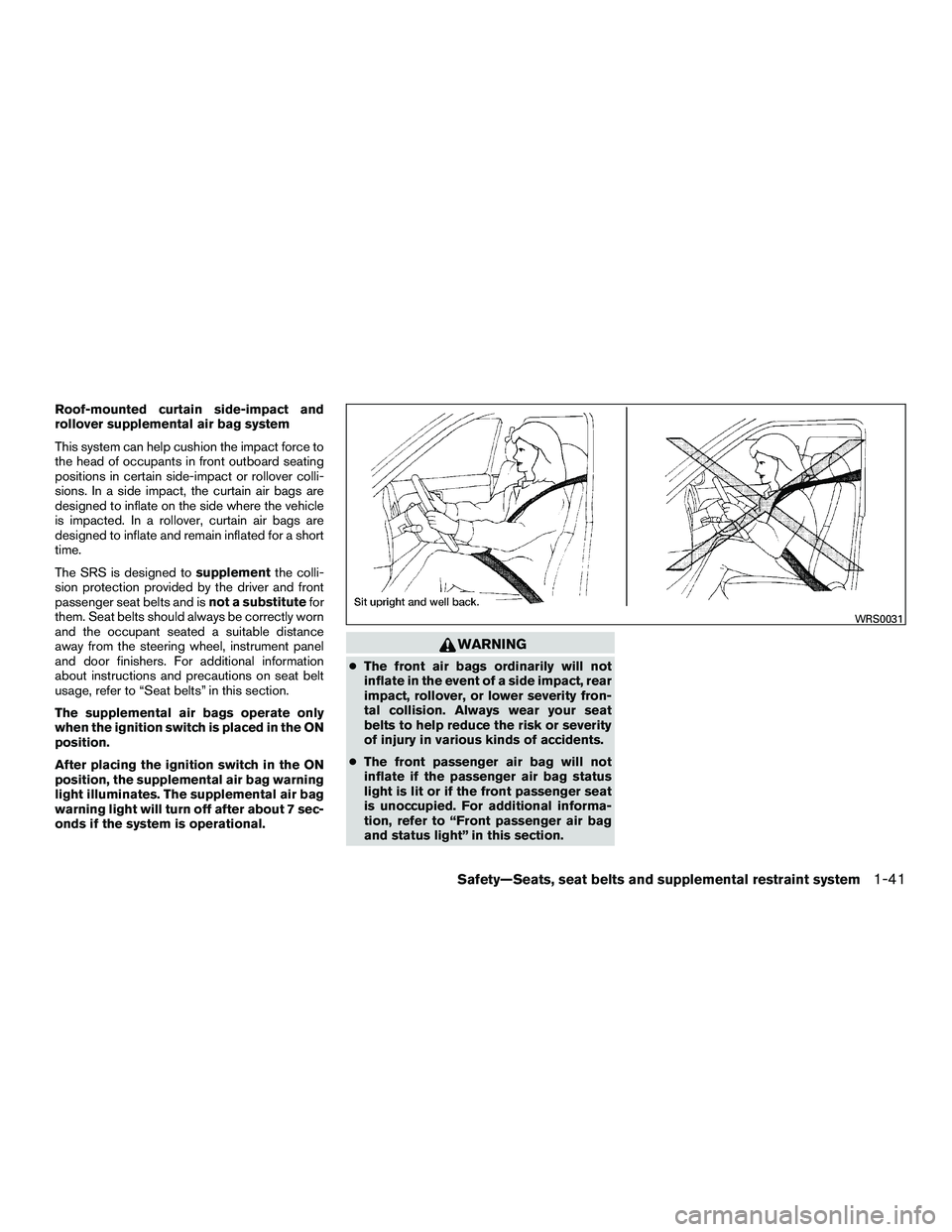
Roof-mounted curtain side-impact and
rollover supplemental air bag system
This system can help cushion the impact force to
the head of occupants in front outboard seating
positions in certain side-impact or rollover colli-
sions. In a side impact, the curtain air bags are
designed to inflate on the side where the vehicle
is impacted. In a rollover, curtain air bags are
designed to inflate and remain inflated for a short
time.
The SRS is designed tosupplementthe colli-
sion protection provided by the driver and front
passenger seat belts and is not a substitutefor
them. Seat belts should always be correctly worn
and the occupant seated a suitable distance
away from the steering wheel, instrument panel
and door finishers. For additional information
about instructions and precautions on seat belt
usage, refer to “Seat belts” in this section.
The supplemental air bags operate only
when the ignition switch is placed in the ON
position.
After placing the ignition switch in the ON
position, the supplemental air bag warning
light illuminates. The supplemental air bag
warning light will turn off after about 7 sec-
onds if the system is operational.
WARNING
● The front air bags ordinarily will not
inflate in the event of a side impact, rear
impact, rollover, or lower severity fron-
tal collision. Always wear your seat
belts to help reduce the risk or severity
of injury in various kinds of accidents.
● The front passenger air bag will not
inflate if the passenger air bag status
light is lit or if the front passenger seat
is unoccupied. For additional informa-
tion, refer to “Front passenger air bag
and status light” in this section.
WRS0031
Safety—Seats, seat belts and supplemental restraint system1-41
Page 65 of 312
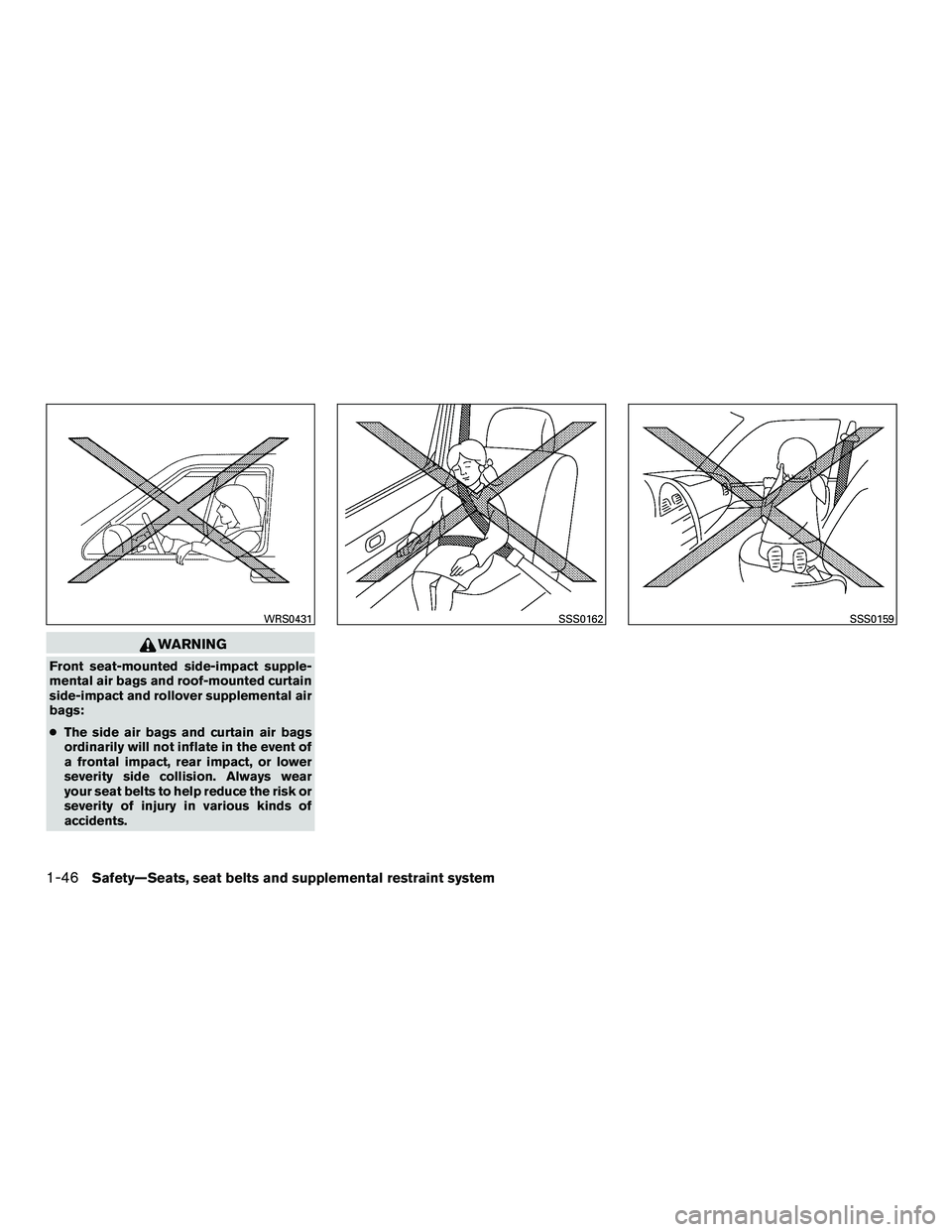
WARNING
Front seat-mounted side-impact supple-
mental air bags and roof-mounted curtain
side-impact and rollover supplemental air
bags:
●The side air bags and curtain air bags
ordinarily will not inflate in the event of
a frontal impact, rear impact, or lower
severity side collision. Always wear
your seat belts to help reduce the risk or
severity of injury in various kinds of
accidents.
WRS0431SSS0162SSS0159
1-46Safety—Seats, seat belts and supplemental restraint system
Page 66 of 312
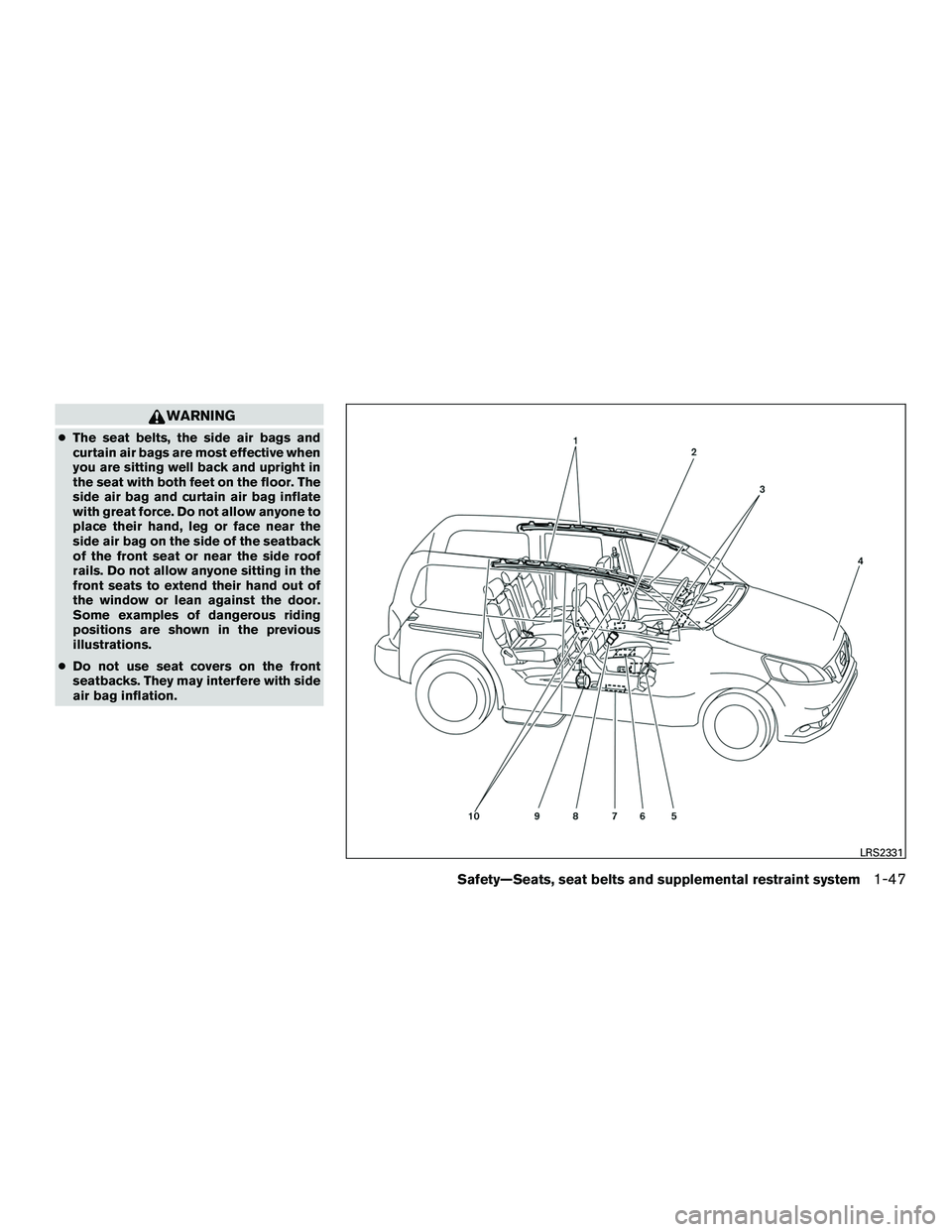
WARNING
●The seat belts, the side air bags and
curtain air bags are most effective when
you are sitting well back and upright in
the seat with both feet on the floor. The
side air bag and curtain air bag inflate
with great force. Do not allow anyone to
place their hand, leg or face near the
side air bag on the side of the seatback
of the front seat or near the side roof
rails. Do not allow anyone sitting in the
front seats to extend their hand out of
the window or lean against the door.
Some examples of dangerous riding
positions are shown in the previous
illustrations.
● Do not use seat covers on the front
seatbacks. They may interfere with side
air bag inflation.
LRS2331
Safety—Seats, seat belts and supplemental restraint system1-47
Page 67 of 312
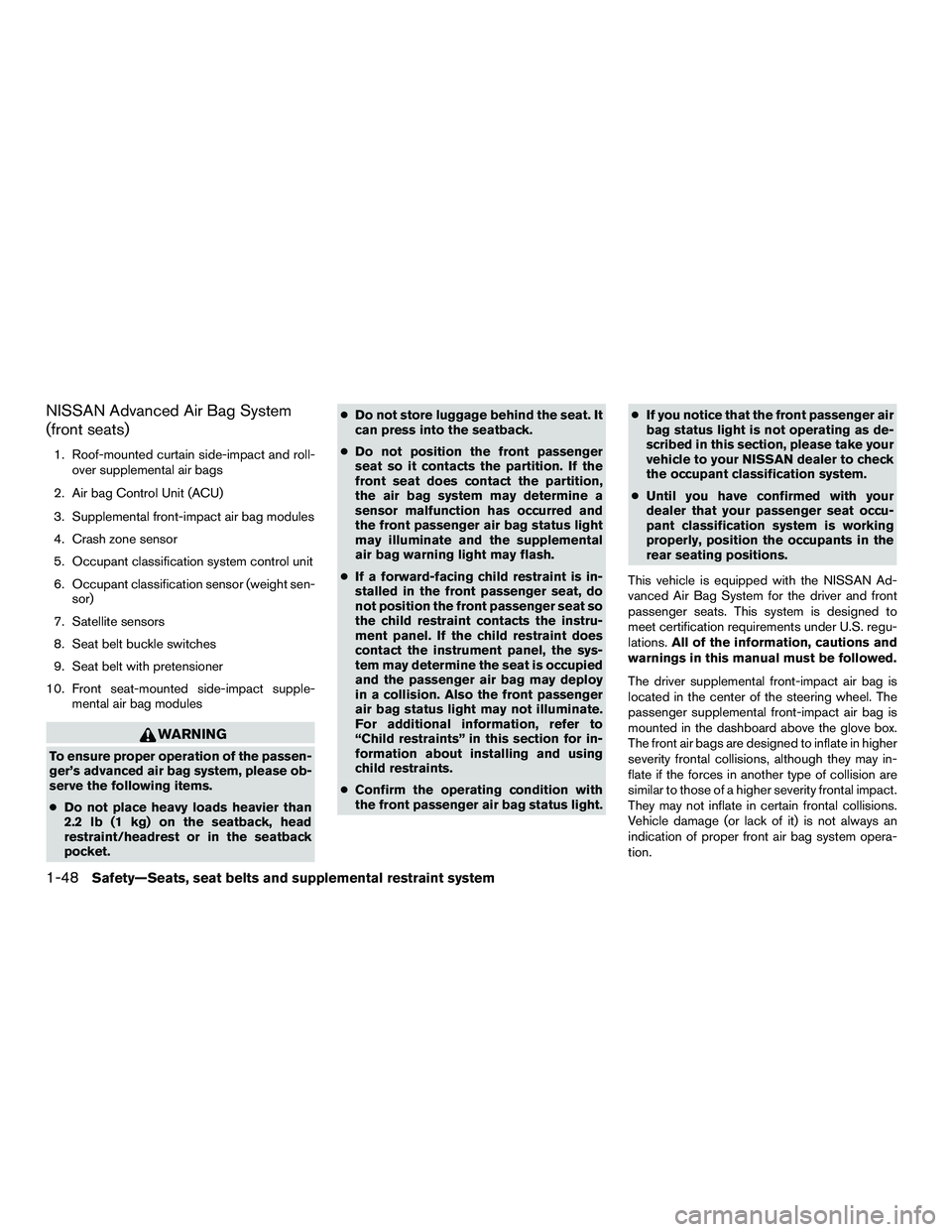
NISSAN Advanced Air Bag System
(front seats)
1. Roof-mounted curtain side-impact and roll-over supplemental air bags
2. Air bag Control Unit (ACU)
3. Supplemental front-impact air bag modules
4. Crash zone sensor
5. Occupant classification system control unit
6. Occupant classification sensor (weight sen- sor)
7. Satellite sensors
8. Seat belt buckle switches
9. Seat belt with pretensioner
10. Front seat-mounted side-impact supple- mental air bag modules
WARNING
To ensure proper operation of the passen-
ger’s advanced air bag system, please ob-
serve the following items.
●Do not place heavy loads heavier than
2.2 lb (1 kg) on the seatback, head
restraint/headrest or in the seatback
pocket. ●
Do not store luggage behind the seat. It
can press into the seatback.
● Do not position the front passenger
seat so it contacts the partition. If the
front seat does contact the partition,
the air bag system may determine a
sensor malfunction has occurred and
the front passenger air bag status light
may illuminate and the supplemental
air bag warning light may flash.
● If a forward-facing child restraint is in-
stalled in the front passenger seat, do
not position the front passenger seat so
the child restraint contacts the instru-
ment panel. If the child restraint does
contact the instrument panel, the sys-
tem may determine the seat is occupied
and the passenger air bag may deploy
in a collision. Also the front passenger
air bag status light may not illuminate.
For additional information, refer to
“Child restraints” in this section for in-
formation about installing and using
child restraints.
● Confirm the operating condition with
the front passenger air bag status light. ●
If you notice that the front passenger air
bag status light is not operating as de-
scribed in this section, please take your
vehicle to your NISSAN dealer to check
the occupant classification system.
● Until you have confirmed with your
dealer that your passenger seat occu-
pant classification system is working
properly, position the occupants in the
rear seating positions.
This vehicle is equipped with the NISSAN Ad-
vanced Air Bag System for the driver and front
passenger seats. This system is designed to
meet certification requirements under U.S. regu-
lations. All of the information, cautions and
warnings in this manual must be followed.
The driver supplemental front-impact air bag is
located in the center of the steering wheel. The
passenger supplemental front-impact air bag is
mounted in the dashboard above the glove box.
The front air bags are designed to inflate in higher
severity frontal collisions, although they may in-
flate if the forces in another type of collision are
similar to those of a higher severity frontal impact.
They may not inflate in certain frontal collisions.
Vehicle damage (or lack of it) is not always an
indication of proper front air bag system opera-
tion.
1-48Safety—Seats, seat belts and supplemental restraint system
Page 74 of 312
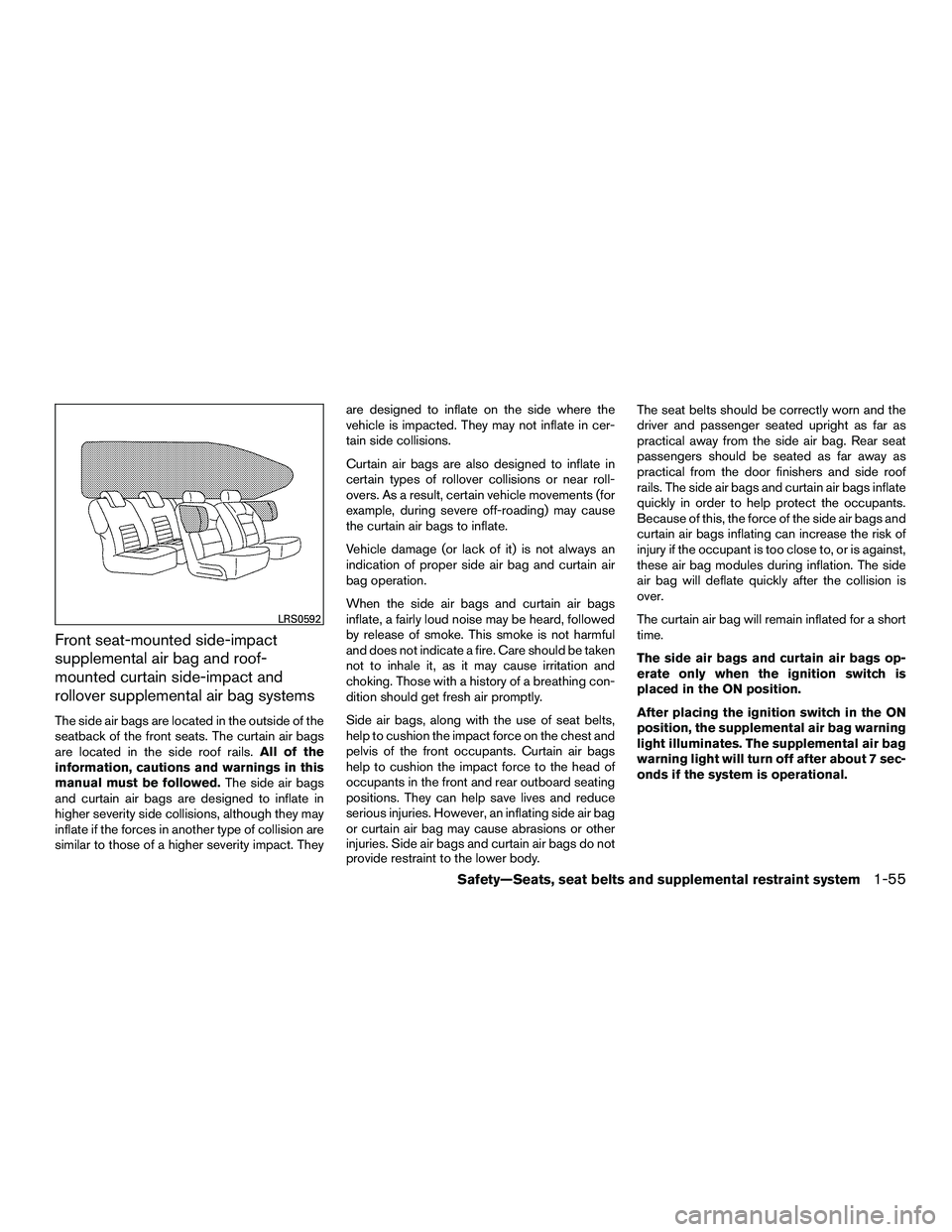
Front seat-mounted side-impact
supplemental air bag and roof-
mounted curtain side-impact and
rollover supplemental air bag systems
The side air bags are located in the outside of the
seatback of the front seats. The curtain air bags
are located in the side roof rails.All of the
information, cautions and warnings in this
manual must be followed. The side air bags
and curtain air bags are designed to inflate in
higher severity side collisions, although they may
inflate if the forces in another type of collision are
similar to those of a higher severity impact. They are designed to inflate on the side where the
vehicle is impacted. They may not inflate in cer-
tain side collisions.
Curtain air bags are also designed to inflate in
certain types of rollover collisions or near roll-
overs. As a result, certain vehicle movements (for
example, during severe off-roading) may cause
the curtain air bags to inflate.
Vehicle damage (or lack of it) is not always an
indication of proper side air bag and curtain air
bag operation.
When the side air bags and curtain air bags
inflate, a fairly loud noise may be heard, followed
by release of smoke. This smoke is not harmful
and does not indicate a fire. Care should be taken
not to inhale it, as it may cause irritation and
choking. Those with a history of a breathing con-
dition should get fresh air promptly.
Side air bags, along with the use of seat belts,
help to cushion the impact force on the chest and
pelvis of the front occupants. Curtain air bags
help to cushion the impact force to the head of
occupants in the front and rear outboard seating
positions. They can help save lives and reduce
serious injuries. However, an inflating side air bag
or curtain air bag may cause abrasions or other
injuries. Side air bags and curtain air bags do not
provide restraint to the lower body.The seat belts should be correctly worn and the
driver and passenger seated upright as far as
practical away from the side air bag. Rear seat
passengers should be seated as far away as
practical from the door finishers and side roof
rails. The side air bags and curtain air bags inflate
quickly in order to help protect the occupants.
Because of this, the force of the side air bags and
curtain air bags inflating can increase the risk of
injury if the occupant is too close to, or is against,
these air bag modules during inflation. The side
air bag will deflate quickly after the collision is
over.
The curtain air bag will remain inflated for a short
time.
The side air bags and curtain air bags op-
erate only when the ignition switch is
placed in the ON position.
After placing the ignition switch in the ON
position, the supplemental air bag warning
light illuminates. The supplemental air bag
warning light will turn off after about 7 sec-
onds if the system is operational.
LRS0592
Safety—Seats, seat belts and supplemental restraint system1-55
Page 80 of 312
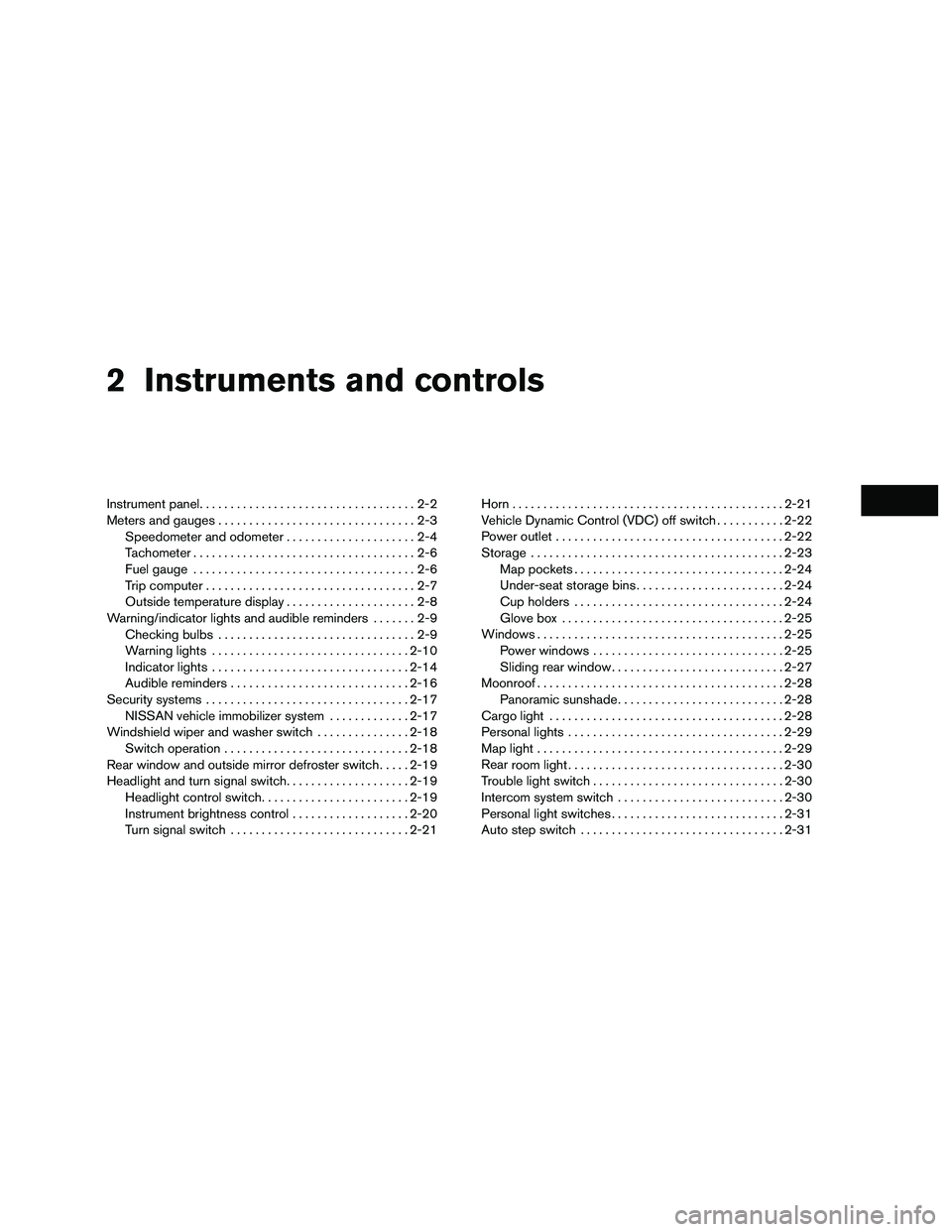
2 Instruments and controls
Instrument panel...................................2-2
Meters and gauges ................................2-3
Speedometer and odometer .....................2-4
Tachometer ....................................2-6
Fuel gauge ....................................2-6
Trip computer ..................................2-7
Outside temperature display .....................2-8
Warning/indicator lights and audible reminders .......2-9
Checking bulbs ................................2-9
Warning lights ................................ 2-10
Indicator lights ................................ 2-14
Audible reminders ............................. 2-16
Security systems ................................. 2-17
NISSAN vehicle immobilizer system .............2-17
Windshield wiper and washer switch ...............2-18
Switch operation .............................. 2-18
Rear window and outside mirror defroster switch .....2-19
Headlight and turn signal switch ....................2-19
Headlight control switch ........................ 2-19
Instrument brightness control ...................2-20
Turn signal switch ............................. 2-21Horn
............................................ 2-21
Vehicle Dynamic Control (VDC) off switch ...........2-22
Power outlet ..................................... 2-22
Storage ......................................... 2-23
Map pockets .................................. 2-24
Under-seat storage bins ........................ 2-24
Cup holders .................................. 2-24
Glove box .................................... 2-25
Windows ........................................ 2-25
Power windows ............................... 2-25
Sliding rear window ............................ 2-27
Moonroof ........................................ 2-28
Panoramic sunshade ........................... 2-28
Cargo light ...................................... 2-28
Personal lights ................................... 2-29
Map light ........................................ 2-29
Rear
room light ................................... 2-30
Trouble light switch ............................... 2-30
Intercom system switch ........................... 2-30
Personal light switches ............................ 2-31
Auto step switch ................................. 2-31
Page 107 of 312
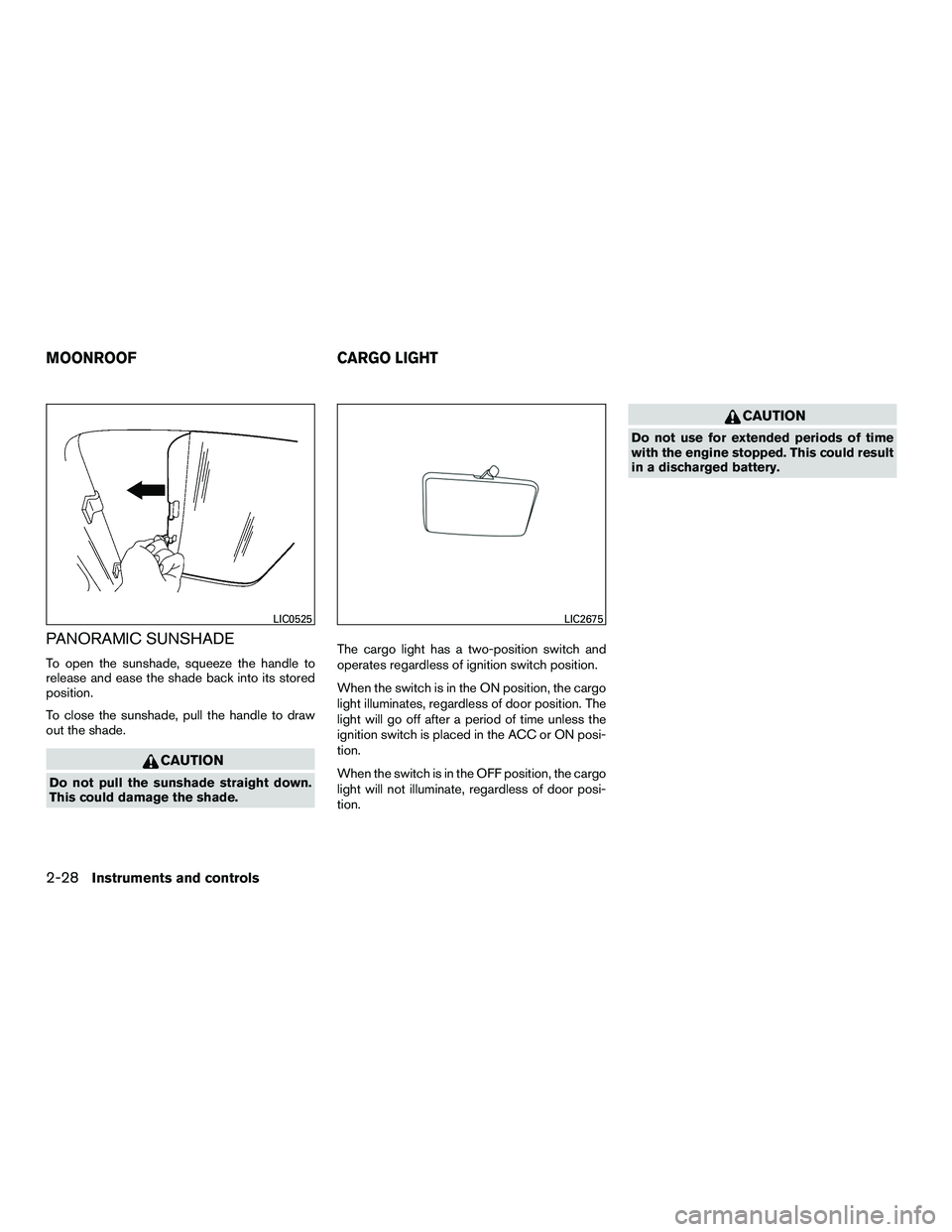
PANORAMIC SUNSHADE
To open the sunshade, squeeze the handle to
release and ease the shade back into its stored
position.
To close the sunshade, pull the handle to draw
out the shade.
CAUTION
Do not pull the sunshade straight down.
This could damage the shade.The cargo light has a two-position switch and
operates regardless of ignition switch position.
When the switch is in the ON position, the cargo
light illuminates, regardless of door position. The
light will go off after a period of time unless the
ignition switch is placed in the ACC or ON posi-
tion.
When the switch is in the OFF position, the cargo
light will not illuminate, regardless of door posi-
tion.
CAUTION
Do not use for extended periods of time
with the engine stopped. This could result
in a discharged battery.
LIC0525LIC2675
MOONROOF
CARGO LIGHT
2-28Instruments and controls